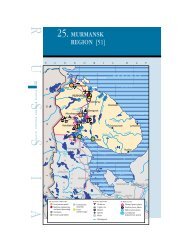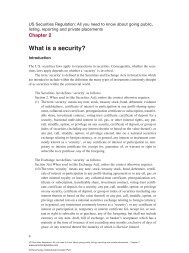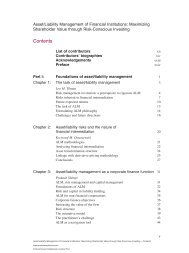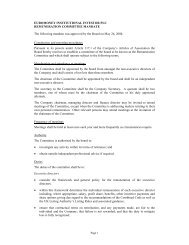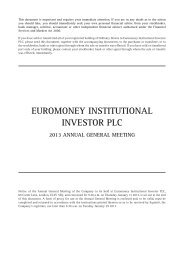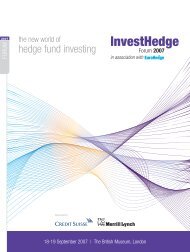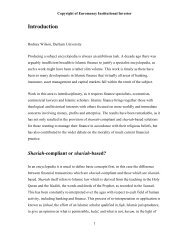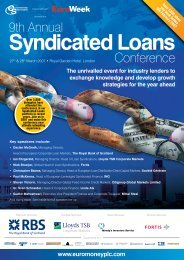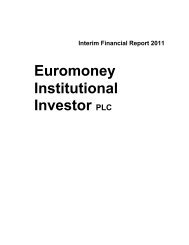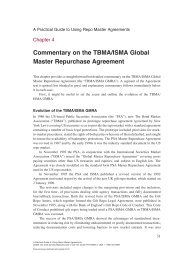Annual Report & Accounts 2012 - Euromoney Institutional Investor ...
Annual Report & Accounts 2012 - Euromoney Institutional Investor ...
Annual Report & Accounts 2012 - Euromoney Institutional Investor ...
You also want an ePaper? Increase the reach of your titles
YUMPU automatically turns print PDFs into web optimized ePapers that Google loves.
<strong>Euromoney</strong> <strong>Institutional</strong> <strong>Investor</strong> PLC <strong>Annual</strong> <strong>Report</strong> and <strong>Accounts</strong> <strong>2012</strong><br />
www.euromoneyplc.com<br />
Notes to the Consolidated<br />
Financial Statements continued<br />
19 Financial instruments and risk management continued<br />
Market risk exposures are measured using sensitivity analysis.<br />
There has been no change to the group’s exposure to market risks or the manner in which it manages and measures the risks during the year.<br />
ii) Foreign exchange rate risk<br />
The group’s principal foreign exchange exposure is to US dollar. The group generates approximately two-thirds of its revenues in US dollars, including<br />
approximately 30% of the revenues in its UK-based businesses, and approximately 60% of its operating profits are US dollar-denominated. The group<br />
is therefore exposed to foreign exchange risk on the US dollar revenues in its UK businesses, the translation of results of foreign subsidiaries and<br />
external loans as well as loans to foreign operations within the group where the denomination of the loan is not in the functional currency of the<br />
lender/borrower.<br />
The carrying amounts of the group’s US dollar-denominated monetary assets and monetary liabilities at the reporting date are as follows:<br />
Assets<br />
Liabilities<br />
<strong>2012</strong><br />
£000<br />
2011<br />
£000<br />
<strong>2012</strong><br />
£000<br />
2011<br />
£000<br />
US dollar 58,770 84,074 (5,956) (7,967)<br />
Subsidiaries normally do not hedge transactions in foreign currencies into the functional currency of their own operations. However, at a group level,<br />
a series of US dollar and Euro forward contracts are put in place to sell forward surplus US dollars and Euros so as to hedge 80% of the group’s UK<br />
based US dollar and Euro revenues for the coming 12 months and 50% of the group’s UK based US dollar and Euro revenues for the subsequent six<br />
months. The timing and value of these forward contracts is based on management’s estimate of its future US dollar and Euro revenues over an 18 month<br />
period and is regularly reviewed and revised with any changes in estimates resulting in either additional forward contracts being taken out or existing<br />
contracts’ maturity dates being moved forward or back. If management materially underestimate the group’s future US dollar and Euro denominated<br />
revenues, this would lead to too few forward contracts being in place and the group being more exposed to swings in US dollar and Euro to sterling<br />
exchange rates. An overestimate of the group’s US dollar and Euro denominated revenues would lead to associated costs in unwinding the excess<br />
forward contracts. The group also has a significant operation in Canada whose revenues are mainly in US dollars. At a group level a series of US dollar<br />
forward contracts is put in place up to 18 months forward to hedge the operation’s Canadian cost base. In addition, each subsidiary is encouraged to<br />
invoice sales in its local functional currency where possible.<br />
Forward exchange contracts are gross settled at maturity.<br />
The following table details the group’s sensitivity to a 10% increase and decrease in sterling against US dollar. A 10% sensitivity has been determined<br />
by the board as the sensitivity rate appropriate when reporting an estimated foreign currency risk internally and represents management’s assessment<br />
of a reasonably possible change in foreign exchange rates at the reporting date.<br />
The sensitivity analysis includes only outstanding foreign currency denominated monetary items and adjusts their translation at the period end for a<br />
10% change in foreign currency rates. The sensitivity analysis includes external loans as well as loans to foreign operations within the group where<br />
the denomination of the loan is not in the functional currency of the lender/borrower. Where sterling strengthens 10% against the relevant currency<br />
a positive number below indicates an increase in profit and equity. For a 10% weakening of sterling against the relevant currency, there would be an<br />
equal and opposite impact on the profit and other equity, and the balances below would be negative.<br />
Impact of 10% strengthening of sterling against US dollar<br />
<strong>2012</strong><br />
£000<br />
2011<br />
£000<br />
Change in profit for the year in income statement (646) (954)<br />
Change in equity 6,606 6,666<br />
94






